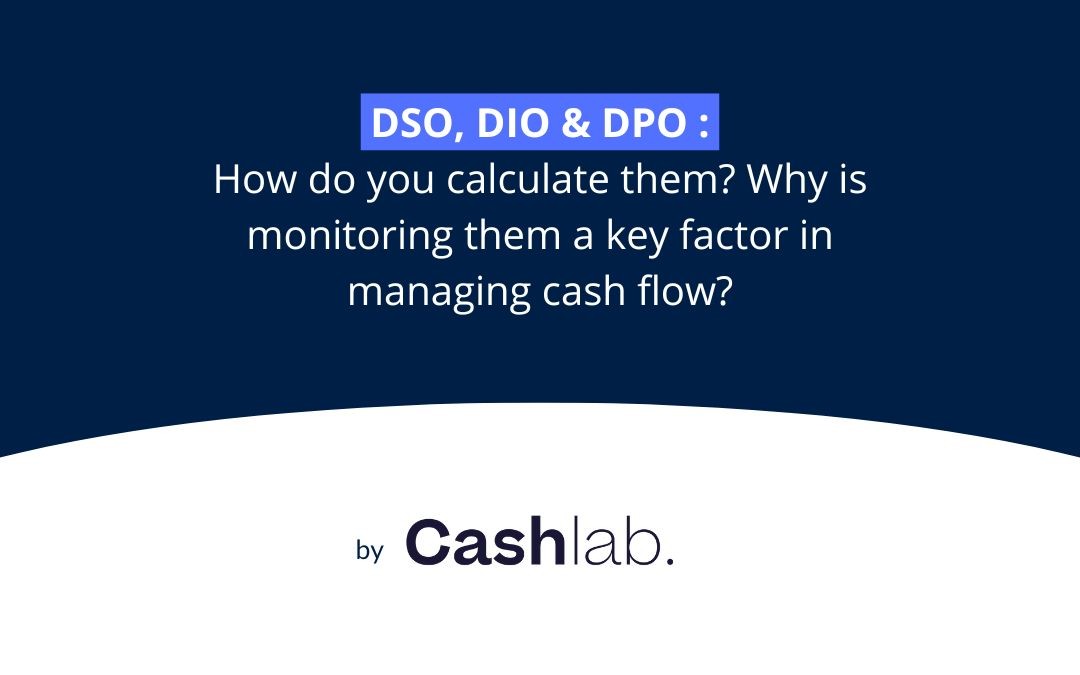Benjamin Madjar, founder and president of Cashlab, reminds us in his speech at the Conference on payment deadlines (and financing) the importance of monitoring working capital KPIs, and more specifically the areas for improvement in working capital management (32min30). He also provides a reminder of the definitions of DSO and DPO (37min20).
DSO, DPO and DIO are three of the most useful acronyms for financial management, but why? And above all, how to calculate them? At Cashlab, we can help you to see more clearly and to understand how important it is to monitor them.
DSO calculation
DSO (Days Sales Outstanding) is the average time (in days of turnover) taken to pay customers. It can be calculated as follows:
DSO = (Créances clients ÷ Chiffre d’affaires TTC) × 365 = x jours
The best method, however, is the clearance method (or Roll or Count Back).
This method consists of "depleting" the outstanding receivables by the turnover (including VAT) of the previous months, and then adding up the number of days in the corresponding months (April = 30 days, August = 31 days). This method takes into account the seasonality of turnover and allows for a more realistic comparison.
⇒ The lower the DSO, the faster your customers pay you (due to your contractual payment terms + possible delay). Conversely, the higher the DSO, the longer it takes your customers to pay you. In this case, you should be able to separate your DSO into two parts: the payment terms contracted with the customer and the additional time taken by the customer to pay you.
DIO calculation
The DIO (Days Inventory Outstanding) or the average storage time (in days of costs) is calculated as follows:
DIO = (Stock moyen ÷ coût d’achat des marchandises vendues) x 365 = x jours
The best method, however, is the clearance method (or Roll or Count Back).
⇒ This calculation gives the volume of stock converted into the number of days of purchases. A distinction can be made between stocks of raw materials, packaging, work-in-progress and finished products to refine the relevance of the ratios calculated.
Another calculation is to use future sales and measure the coverage of sales with stocks of finished products.
DPO calculation
The DPO (Days Payable Outstanding) is the average time (in purchasing days) taken to pay supplier invoices. It is calculated as follows:
DPO = (Supplier debts ÷ Purchases) x 365 = x days
The best method, however, is the clearance method (or Roll or Count Back).
⇒ The higher the DPO, the later your company pays its suppliers. The DPO should be as consistent as possible with the contractual terms with your suppliers.
All the subtlety lies in the fine-tuning of the elements relating to receipts (DSO) and those relating to disbursements (DPO), in order to minimise the need to finance the working capital requirement.
DSO, DPO and DIO: why and how to assemble these indicators?
There is an interesting indicator (even if mathematically false because the same denominators are not used) that brings these 3 indicators together, it is the Cash conversion cycle, also called CCC. The CCC is calculated as follows:
DIO + DSO - DPO = x days
It is the reflection of your operational WCR.
This is a key indicator in the management of the WCR because a good action plan must take into account actions on:
- Clients: contractual review of payment deadlines, effective reminder process, etc.
- Suppliers: negotiate payment terms as best as possible, pay on time with a clear internal process (too many companies pay on the fly),
- Stocks: periodic monitoring of outstanding stocks at a minimum...
Manage your cash flow and save time
To calculate and monitor these ratios efficiently, Cashlab has integrated them natively into the platform and has added (1) automatic calculations of theoretical gains (a real return on investment from the first connection) and (2) self-assessments to help your teams adopt the right business gestures and integrate a real Cash culture.
Closely monitor your cash flow in a clear and optimised manner with our Cashlab tool.
Les 5 étapes clés pour construire un budget de trésorerie
Le budget de trésorerie est un outil prévisionnel qui permet à une entreprise d’anticiper ses flux de trésorerie. Il recense tous les encaissements (entrées d’argent) et tous les décaissements (sorties d’argent) sur une période donnée, souvent mensualisé.
Exclusive interview with Jennifer Serfati, Founder of consultancy Hart Group
Jennifer Serfati tells us about the origins, missions and challenges of her consultancy Hart Group. ‘Our motto, ‘The partner for balancing your cash flow’, illustrates our commitment to supporting our customers with a 360° vision’.
CASHLAB x CHIFT
Chift is the fruit of the experience of its three founders in companies specialising in systems integration. After visiting around a hundred companies and analysing the problem, they identified a major gap in the integration market. That's how they came up with Chift, a unified API.
![]()
📍1, rue des Prouvaires
75001 Paris
Follow us:
©2023 All rights reserved. | Cashlab | Legal Notice




